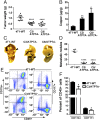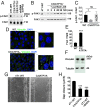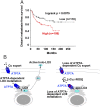ATP7A delivers copper to the lysyl oxidase family of enzymes and promotes tumorigenesis and metastasis
- PMID: 30890638
- PMCID: PMC6452744
- DOI: 10.1073/pnas.1817473116
ATP7A delivers copper to the lysyl oxidase family of enzymes and promotes tumorigenesis and metastasis
Abstract
Lysyl oxidase (LOX) and LOX-like (LOXL) proteins are copper-dependent metalloenzymes with well-documented roles in tumor metastasis and fibrotic diseases. The mechanism by which copper is delivered to these enzymes is poorly understood. In this study, we demonstrate that the copper transporter ATP7A is necessary for the activity of LOX and LOXL enzymes. Silencing of ATP7A inhibited LOX activity in the 4T1 mammary carcinoma cell line, resulting in a loss of LOX-dependent mechanisms of metastasis, including the phosphorylation of focal adhesion kinase and myeloid cell recruitment to the lungs, in an orthotopic mouse model of breast cancer. ATP7A silencing was also found to attenuate LOX activity and metastasis of Lewis lung carcinoma cells in mice. Meta-analysis of breast cancer patients found that high ATP7A expression was significantly correlated with reduced survival. Taken together, these results identify ATP7A as a therapeutic target for blocking LOX- and LOXL-dependent malignancies.
Keywords: breast cancer; copper; lung cancer; lysyl oxidase; metastasis.
Conflict of interest statement
The authors declare no conflict of interest.
Figures





Similar articles
-
Single-cell tracking demonstrates copper chaperone Atox1 to be required for breast cancer cell migration.Proc Natl Acad Sci U S A. 2020 Jan 28;117(4):2014-2019. doi: 10.1073/pnas.1910722117. Epub 2020 Jan 13. Proc Natl Acad Sci U S A. 2020. PMID: 31932435 Free PMC article.
-
Pulmonary lysyl oxidase expression and its role in seeding Lewis lung carcinoma cells.Clin Exp Metastasis. 2024 Dec 23;42(1):7. doi: 10.1007/s10585-024-10325-y. Clin Exp Metastasis. 2024. PMID: 39714512
-
Copper Transporter ATP7A (Copper-Transporting P-Type ATPase/Menkes ATPase) Limits Vascular Inflammation and Aortic Aneurysm Development: Role of MicroRNA-125b.Arterioscler Thromb Vasc Biol. 2019 Nov;39(11):2320-2337. doi: 10.1161/ATVBAHA.119.313374. Epub 2019 Sep 26. Arterioscler Thromb Vasc Biol. 2019. PMID: 31554420 Free PMC article.
-
Role of the lysyl oxidase enzyme family in cardiac function and disease.Cardiovasc Res. 2019 Nov 1;115(13):1820-1837. doi: 10.1093/cvr/cvz176. Cardiovasc Res. 2019. PMID: 31504232 Review.
-
Lysyl Oxidase and the Tumor Microenvironment.Int J Mol Sci. 2016 Dec 29;18(1):62. doi: 10.3390/ijms18010062. Int J Mol Sci. 2016. PMID: 28036074 Free PMC article. Review.
Cited by
-
Copper-Dependent Kinases and Their Role in Cancer Inception, Progression and Metastasis.Biomolecules. 2022 Oct 20;12(10):1520. doi: 10.3390/biom12101520. Biomolecules. 2022. PMID: 36291728 Free PMC article. Review.
-
Development and validation of a cuproptosis-associated prognostic model for diffuse large B-cell lymphoma.Front Oncol. 2023 Jan 12;12:1020566. doi: 10.3389/fonc.2022.1020566. eCollection 2022. Front Oncol. 2023. PMID: 36713586 Free PMC article.
-
Cuproptosis predicts the risk and clinical outcomes of lung adenocarcinoma.Front Oncol. 2022 Aug 8;12:922332. doi: 10.3389/fonc.2022.922332. eCollection 2022. Front Oncol. 2022. PMID: 36003780 Free PMC article.
-
Cysteine oxidation of copper transporter CTR1 drives VEGFR2 signalling and angiogenesis.Nat Cell Biol. 2022 Jan;24(1):35-50. doi: 10.1038/s41556-021-00822-7. Epub 2022 Jan 13. Nat Cell Biol. 2022. PMID: 35027734 Free PMC article.
-
Regulatory roles of copper metabolism and cuproptosis in human cancers.Front Oncol. 2023 Mar 23;13:1123420. doi: 10.3389/fonc.2023.1123420. eCollection 2023. Front Oncol. 2023. PMID: 37035162 Free PMC article. Review.
References
Publication types
MeSH terms
Substances
Grants and funding
LinkOut - more resources
Full Text Sources
Other Literature Sources
Research Materials

